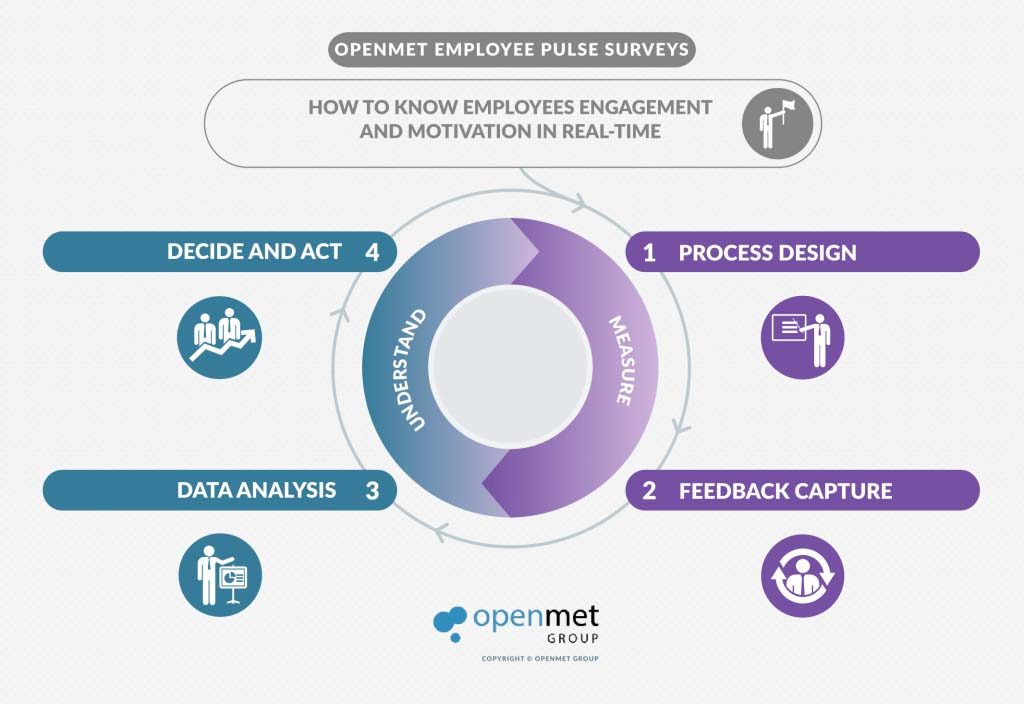How often have you heard and read that “the most engaged employees have better attitudes on a day-to-day basis and are better able to adapt to change”? But, in spite of this, do we exert any kind of control over our teams’ commitment?
Openmet People’s history shows that, in a high proportion of cases, the answers to the above question are along the lines of “Yes, we measure engagement and work climate”.
It is essential to regularly assess your team’s engagement and work climate.
Measurements are usually made every two years and cover very complete analyses. However, organizations tend to undergo ever faster changes that can affect employees’ commitment and motivation.
For this reason, at Openmet People we believe in the need to carry out ongoing commitment and organizational climate assessments as a technique to ascertain and track certain actions and detect possible deviations. For this reason, we have developed a continuous assessment method that enables us to establish aspects of the company’s short-term organizational climate while identifying and measuring the key aspects of employees’ engagement.
How can you ascertain employees’ engagement and motivation in real time?
Below is a brief explanation of the stages of this method.
1. DESIGNING THE PROCESS
The first stage is the “questionnaire design and adaptation” stage, in which the relevant questions and KPIs are chosen with the help and support of Openmet People and its 5F work climate model as reference. The questionnaire contains 1 or 2 fixed questions that act as trend indicators. The variable questions (between 2 and 4) are designed to gather information about aspects of interest to the organization, such as analyzing the impact of implementing a new cross-communication practice through questions relating to collaboration and inter-departmental communication.
2. OBTAINING FEEDBACK
This is followed by the second stage, which involves obtaining feedback from employees through electronic questionnaires.
The frequency of release – weekly, fortnightly or monthly – can be adjusted based on the customer’s needs.
In addition, this action is carried out either on a sample of employees as a fixed panel – in other words, they periodically repeat the questionnaire – or on a randomized and controlled panel for which a representative sample will be selected for each release.
3. ANALYZING THE DATA
During the survey completion period, the customer can access the Business Intelligence results environment, which facilitates real-time tracking in relation to both participation and results.
The system makes it possible to analyze the results, based on pre-defined questions, in a way that is completely intuitive and devoid of technical complexity. As the work is based on indicators, results are presented in summarized form and make it possible to aggregate results from previous periods to the current results, providing a specific view of a given period as well as an overview of the aggregated results.
4. DECIDING AND ACTING
DThe final stage involves reporting the results to the key people and making decisions about possible areas of action.
At this point, the pre-established demographic segmentation will help you work in a more focused manner by division, job or type of contract.
Points to bear in mind about EmployeePS
The main points to bear in mind when putting in place this kind of continuous assessment system are:
– A system that makes it possible to obtain results in real time and obtain an advanced analysis thereof.
– The support of a partner with work climate and engagement expertise who can provide advice for the establishment of questions, the interpretation of results and possible actions for improvement.
– Properly defining the panel of respondents and, based on this, the frequency of questionnaires.
– Focusing and diversifying the questions in each wave.
– A very high frequency can considerably reduce the number of responses and general interest in the tool.
– Working with medium and high KPIs makes it possible to conduct a summarized analysis of the results and identify areas for improvement.
– It is useful to work with data from segments such as departments, job types, etc.
– Having both internal and external benchmarking.
– The possibility of team managers accessing the results.
– An attractive design of the electronic survey will result in greater participation.
EmployeePS is the ideal assessment method for employee-centered companies, as it becomes a technological consulting tool that assesses both key aspects of the organization’s work climate and employees’ commitment and motivation, facilitating rapid detection and action in any critical areas found.
And you, what do you think of the importance of ascertaining the engagement and motivation of a company’s employees?




